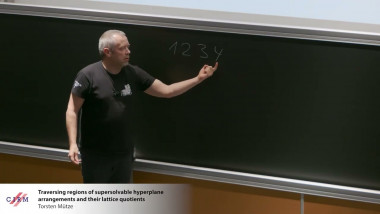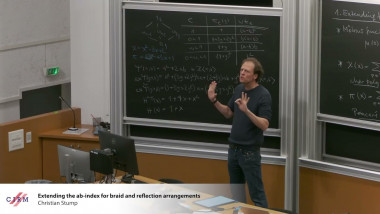
Traversing regions of supersolvable hyperplane arrangements and their lattice quotients
By Torsten Mütze

Extending the ab-index for braid and reflection arrangements
By Christian Stump
Appears in collection : Probability and Geometry in, on and of non-Euclidian spaces / Probabilités et géométrie dans, sur et des espaces non-euclidiens
I will discuss percolation on the Voronoi tessellation generated by a homogeneous Poisson point process on the hyperbolic plane. That is, to each point $z$ of a constant intensity Poisson point process Z on the hyperbolic plane we assign its Voronoi cell – the region consisting of all points that are closer to z than to any other $z'$ in $Z$ –and we colour each cell black with probability p and white with probability 1 - p, independently of the colours of all other cells. We say that percolation occurs if there is an infinite connected cluster of black cells.Hyperbolic Poisson-Voronoi percolation was first studied by Benjamini and Schramm about twenty years ago. Their results show that there are spectacular differences with the corresponding model in the Euclidean plane.I will sketch joint work with my recently graduated doctoral student Ben Hansen that resolves a conjecture and an open question, posed by Benjamini and Schramm, on the behaviour of the “critical probability for percolation” as a function of the intensity parameter of the underlying Poisson process. (Unlike in Euclidean Poisson-Voronoi percolation, this critical value depends on the intensity of the underlying Poisson process.) Based on joint work with Benjamin Hansen.
